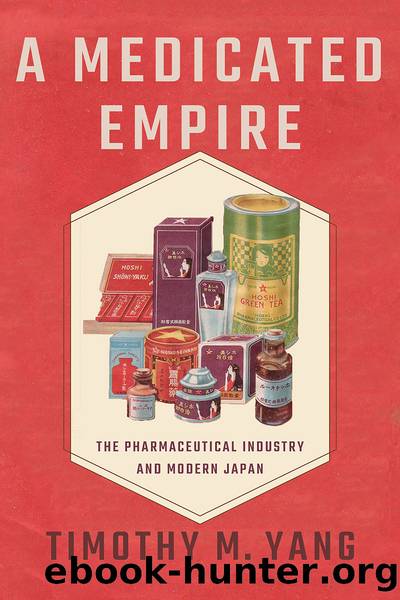A Medicated Empire by Timothy M. Yang

Author:Timothy M. Yang
Language: eng
Format: epub
Publisher: Cornell University Press
Published: 2021-02-27T00:00:00+00:00
Part IV
SCIENCE, SELF-SUFFICIENCY, AND WARTIME MOBILIZATION
7
SELLING THE SCIENCE OF QUININE SELF-SUFFICIENCY
On April 30th, 1934, Hoshi Hajime hosted a roundtable discussion in the ballroom of the Taihoku Railway Hotel. The topic was Hoshi Pharmaceuticalsâ proposal to cultivate cinchona (kina) near aboriginal villages in the mountains of Taiwan. Cinchona, a tree indigenous to South America, provided the raw material for one of the most important drugs in the early twentieth century, the anti-malarial drug quinine. At the time, roughly 90 percent of the worldâs supply came from Dutch plantations in Java. A monopoly known as the Kina Bureau, headquartered in Amsterdam, controlled its production and distribution.1
Aligning corporate profit motives with national interests, Hoshi Hajime capitalized on government fears of medicinal scarcity to present quinine self-sufficiency as synonymous with the security of the Japanese Empire, which at this time was rapidly expanding into Manchuria and northeastern China. Hoshi presented a ten-year plan for cultivating cinchona on roughly 120 square kilometers of land in plantations in the mountains of Gaoxiong Prefecture in southwest Taiwan and in Taidong Province in the southeast. Hoshi declared that his company would, at minimum, provide 3 million yen for the project for a period of three yearsâan enormous sum. Hoshi argued that plan would cost upward of 10 million yen if it were carried out in a different location, presumably without cheap, aboriginal labor. He had a business partner in this venture, William Hosken, who would also provide some capital. Hoshi hoped that additional funding would come from the Japanese government-general of Taiwan, particularly from the Central Research Institute, which would have its own research laboratory on the premises.2
Hoshi Pharmaceuticalsâ proposal for a âgreater cinchona empireâ (dai kina teikoku) was a metaphor for Japanâs colonial project, replete with allusions to civilizing the barbarians and arguments for autarky, not to mention the matter-of-fact logic of the benefits of modern science. This vision appealed to a wide range of actors, including colonial authorities who wanted to tame the aboriginal population; botanists and medical doctors who strove to cure tropical disease through the advance of botanical science; and major firms like the state-sponsored Taiwan Development Company (Taiwan takushoku kabushiki kaisha), which dreamed of exploiting the potential of the islandâs tropical environment for industrial agriculture. It also appealedâas discussed in chapter 8âto military officials concerned with Japanâs quinine reserves as its empire expanded into Southeast Asia.
The quinine venture had particular importance for Hoshi Pharmaceuticals. After bankruptcy, a massive labor strike, and lingering suspicions of its involvement with global narcotics trafficking, the venture was a way to recover the companyâs finances and reputation. Taiwan had been integral to the companyâs early success, and it was the locus of the opium-trading scandal that nearly destroyed the company. By returning to Japanâs first formal colony with a plan to produce a medicine that stood for everything opium was not, Hoshi wanted to prove to the public that he and his company remained a humanitarian business that put âKindness First.â
Hoshi Pharmaceuticals was not alone in such a venture.
Download
This site does not store any files on its server. We only index and link to content provided by other sites. Please contact the content providers to delete copyright contents if any and email us, we'll remove relevant links or contents immediately.
| Biographies | Company Profiles |
| Economic History |
Pale Blue Dot by Carl Sagan(4960)
The Rules Do Not Apply by Ariel Levy(4912)
Goodbye Paradise(3767)
Ogilvy on Advertising by David Ogilvy(3557)
Liar's Poker by Michael Lewis(3416)
Delivering Happiness by Tony Hsieh(3398)
Into Thin Air by Jon Krakauer(3350)
Purple Cow by Seth Godin(3169)
Rogue Trader by Leeson Nick(3013)
The Social Psychology of Inequality by Unknown(2990)
The Airbnb Story by Leigh Gallagher(2822)
4 - Harry Potter and the Goblet of Fire by J.K. Rowling(2686)
The Mind Map Book by Tony Buzan(2549)
Bossypants by Tina Fey(2502)
Claridge's: The Cookbook by Nail Martyn & Erickson Meredith(2385)
All the President's Men by Carl Bernstein & Bob Woodward(2348)
Six Billion Shoppers by Porter Erisman(2283)
Master of the Game by Sidney Sheldon(2267)
Alibaba by Duncan Clark(2060)
